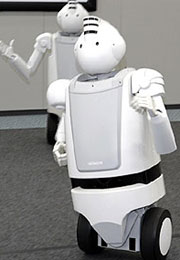 |
| Pal and Chum impressed with their chat
and fast moves | |
Japanese electronics firm Hitachi has unveiled its
first humanoid robot, called
Emiew, to challenge Honda's Asimo and Sony's Qrio robots.
Two wheel-based Emiews, Pal and Chum, introduced themselves to
reporters at a press conference in Japan.
They will be guests at this month's World Expo. Sony and Honda have
both built robots to showcase engineering.
Explaining why Hitachi's Emiew used wheels instead of feet, Toshihiko
Horiuchi, from Hitachi's Mechanical Engineering Research Laboratory, said:
"We aimed to create a robot that could live and co-exist with people. We
want to make the robots useful for people. If the robots moved slower than
people, users would be frustrated."
Emiew - Excellent Mobility and Interactive Existence as Workmate - can
move at 6km/h on its "wheel feet".
With sensors on the head,
waist, and near the wheels, Pal and Chum demonstrated how they could react
to commands. Hitachi said Pal and Chum, which have a vocabulary of about
100 words, could be "trained" for practical office and factory use in as
little as five to six years.
Robotics researchers have long been challenged by developing robots
that walk in the gait of a
human. At the recent AAAS (American Association for the Advancement of
Science) annual meeting in Washington DC, researchers showed off bipedal
designs.
The three designs, each built by a different research group, use the
same principle to achieve a human-like gait. Sony and Honda have both used
humanoid robots, which are not commercially available, as a way of showing
off computing power and engineering expertise.
Honda's Asimo was "born" five years ago. Since then, Honda and Sony's
Qrio have tried to trump each
other with what the robots can do at various technology events.
Asimo has visited the UK, Germany, the Czech Republic, France and
Ireland as part of a world tour.
Sony's Qrio has been singing, jogging and dancing in formation around
the world too and was, until last year, the fastest robot on two legs.
But its record was beaten by Asimo. It is capable of 3km/h, which its
makers claim is almost four times as fast as Qrio.
By 2007, it is predicted that there will be almost 2.5 million
"entertainment and leisure" robots in homes, compared to about 137,000
currently, according to the United Nations (UN).
By the end of that year, 4.1 million robots will be doing jobs in
homes, said a report by the UN Economic Commission for Europe and the
International Federation of Robotics.
(Agencies) |
日本著名的電子公司“日立”推出了它的第一款擬人化機器人Emiew,以挑戰本田公司的Asimo機器人和索尼公司的Qrio機器人。
在日本的一次新聞發布會上,兩名裝著輪子的Emiew機器人“好朋友”和“好伙伴”向記者們作了自我介紹。
他們將成為本月舉行的世界博覽會的“嘉賓”。索尼和本田都曾經制造過機器人,以顯示公司的技術實力。
在解釋Emiew機器人為什么采用輪子而不是雙腳時,日立機械工程研究實驗室的年顏掘內說:“我們的目標是制造可以和人類共同生活的機器人。我們希望這種機器人對人類有幫助。如果機器人走得比人慢,使用者們會感到非常失望。”
Emiew具有出色的靈活性和與人交流合作的工作能力,它以輪代步的速度可以達到6千米每小時。
機器人“好朋友”和“好伙伴”的頭部、腰部和輪子附近都裝有傳感器,它們示范了如何通過傳感器對指令做出反應。日立公司表示,“好朋友”和“好伙伴”能夠識別的詞匯量為100個單詞,經過“訓練”后,它們有望在五六年內進入辦公室和工廠從事實際工作。
機器人技術研究者們長期以來致力于研究可模仿人類步態行走的機器人。最近,在美國科技進步協會的華盛頓年會上,研究者們展示了“雙足機器人”的設計方案。
現場的三種設計方案分別來自不同的研究小組,但他們不約而同地采用了相同的原理來使機器人模擬人類走路的步態。索尼和本田都使用了擬人化機器人,這種機器人并不投入商業生產,只是為了展示制造者的計算機能力和工程技術水平。
本田的Asimo機器人是五年前“出生”的,從那時起,本田公司就和Qrio機器人的制造者索尼公司展開了競爭,試圖讓自己的機器人在廣泛的技術領域里起到的作用超過對手。
目前Asimo機器人已經訪問了英國、德國、捷克、法國和愛爾蘭等國,完成了它的“世界之旅”的一部分。
索尼的Qrio機器人也進行了“環球巡回演出”,包括編成隊列唱歌、慢跑和跳舞,截止到去年,它還是世界上用兩條腿跑得最快的機器人。
但是它的記錄被Asimo機器人打破了。Asimo的移動速度達到3千米每小時,它的制造者稱這幾乎是Qrio速度的四倍。
據聯合國預測,到2007年將有近250萬“娛樂休閑性”機器人進入家庭,目前這個數字是13.7萬。
聯合國歐洲經濟委員會和機器人技術國際聯盟聯合公布的一份報告說,到2007年年底,將有410萬機器人在家庭中工作。
(中國日報網站譯) |
